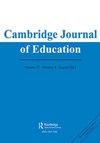衡量英格兰地方教育市场中的种族学校隔离
IF 1.5
3区 教育学
Q2 EDUCATION & EDUCATIONAL RESEARCH
引用次数: 0
摘要
尽管英国学龄人口的种族多样性日益增加,但关于种族学校隔离的学术文献仍然很少,过时并且受到方法论挑战的阻碍。本研究试图通过使用两种方法创新来衡量2006-2019年间的种族学校隔离,从而解决这些问题。首先,这是英国第一个采用多群体隔离指数来衡量五大群体之间的隔离的国家研究。其次,它使用聚类算法将当地学校分组为“伪社区”,这允许在当地教育市场内衡量隔离。文章显示,在2006年至2019年期间,英国伪社区内种族隔离的中位数下降了25%,这表明来自不同种族的学生在当地学校的分布更加均匀。此外,英格兰北部地区的种族隔离程度通常高于南部地区。本文章由计算机程序翻译,如有差异,请以英文原文为准。
Measuring ethnic school segregation within local educational markets in England
ABSTRACT Despite the increasing ethnic diversity of England’s school-age population, academic literature on ethnic school segregation remains small, dated and hindered by methodological challenges. This study seeks to address these issues by measuring ethnic school segregation between 2006–2019 using two methodological innovations. Firstly, it is the first national study in England to adopt a multi-group segregation index to measure segregation between five major groups in a single concise metric. Secondly, it uses a clustering algorithm to group local schools into ‘pseudo-neighbourhoods’, which allows for segregation to be measured within local educational markets. The article shows that between 2006 and 2019 the median level of ethnic school segregation within English pseudo-neighbourhoods fell by 25%, which suggests students from different ethnic groups have become more evenly spread across local schools. Additionally, areas in the North of England were typically found to have higher levels of segregation than those in the South.
求助全文
通过发布文献求助,成功后即可免费获取论文全文。
去求助
来源期刊

Cambridge Journal of Education
EDUCATION & EDUCATIONAL RESEARCH-
CiteScore
5.30
自引率
4.30%
发文量
35
期刊介绍:
Cambridge Journal of Education publishes original refereed articles on all aspects of education, with a particular emphasis on work that contributes to a shared understanding amongst academic researchers, theorists, practising teachers, policy-makers and educational administrators. The journal also welcomes the submission of systematic review articles that summarise and offer new insights into specific areas of educational concern. With a wide international readership, Cambridge Journal of Education publishes contributions drawn from different educational systems and cultures enabling continued in-depth discussion of global educational theory, policy and practice. The journal’s Special Issue programme encourages and stimulates focused discussion and engagement with significant themes and responses to topics raised by readers and contributors. Cambridge Journal of Education welcomes proposals for future editions.
 求助内容:
求助内容: 应助结果提醒方式:
应助结果提醒方式:


